LIVING AT HIGH ALTITUDES
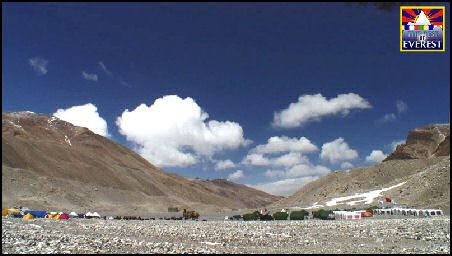
Everest base camp on Tibetan sideThe boiling temperature of water is so low that boiling water from a pot doesn't burn when it touches the skin.Vehicles often breakdown because of the elevation and are restarted again after fluid is sucked from the engine with a tube. Tibet is so cold and arid that metal spoons sometimes stick to the lips and germs that cause many diseases can not survive. Lice, however, like to crawl all over the body to get warm.
Tibetans on the dry Tibetan plateau have little water for washing and have traditionally considered washing to be an unhealthy, harmful practice. As a result many Tibetans are very dirty: their faces and hands are sometimes covered in a layer of greasy yak-butter and dirt, their clothes are caked in dirt and their hair is matted.
When Tibetan nomads do wash, they tend to rinse their faces and hands in yak or goat milk. To protect their skin and beautify themselves some nomad women apply a salve to their face made from boiled milk curds. Some people go through the entire life without ever taking bath. Many Tibetans go barefoot even in sub-freezing temperatures. Not surprisingly their feet have thick leathery dark calluses on them. To keep from getting frostbite in severe cold they wrap their feet in woolen rags. To prevent snow blindness men wrap their long braids over their eyes and women smear black soot under their eyes.
People weigh more at sea level than they do in higher levels. Not by much, but at measurable levels. Weight is a measurement of gravitation pull, in the this case between the earth and a person. The farther away you are from the bulk of the mass of one object the less gravitational pull. By one estimate a person who weights 150 pounds at seas level would weigh 149.92 at 3,050 meters (10,000 feet).
See Separate Articles TIBETAN PEOPLE Factsanddetails.com/China ; TIBETAN LIFE Factsanddetails.com/China ; FOOD, DRINK, DRUGS AND CLOTHES IN TIBET Factsanddetails.com/China ; TIBETAN HEALTH AND MEDICINE Factsanddetails.com/China ; TIBETAN NOMADS Factsanddetails.com/China
RECOMMENDED BOOKS: “High Altitude: Human Adaptation to Hypoxia” by Erik R. Swenson and Peter Bärtsch Amazon.com; “Travel Health Experience in High Altitude Destination: Case Studies of Sagarmatha National Park (Nepal) and Tibet (China)” by Ghazali Musa Amazon.com; “Ward, Milledge and West’s High Altitude Medicine and Physiology” by Andrew M Luks, Philip N Ainslie, et al. Amazon.com
High Altitude Health Problems
Human beings are not very well adapted for high altitudes. Above 18,000 feet, cuts don't heal and women can not bear children. The air is so thin that they can not get enough oxygen into their blood to sustain a fetus growing within their womb. The dry air produces hacking coughs which are strong enough to produce cracked and separated ribs.
Karen Coates wrote in Archaeology magazine: “Working at such heights can be excruciating. A throbbing head, aching lungs, sleeplessness, fatigue, wheezing, coughing, confusion, and rapid pulse are all associated with hypoxia, a condition where tissues can’t get enough oxygen. It occurs when people accustomed to living at lower altitudes climb above 8,000 feet, and it can be dangerous and lead to pulmonary edema, stroke, and even death. Women who aren’t adapted to high elevations can have a much harder time bearing children and risk having low-birth-weight babies. [Source: Karen Coates, Archaeology magazine, September-October 2017]
High Altitude Health Adaptions
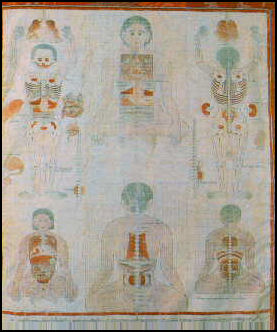
thangka of the human body Tibetan nomads that live above 5500 meters (18,000 feet) often suffer discomfort when they descend to Lhasa at 3,500 meters (11,550 feet). They have as much as 22 percent more oxygen-carrying hemoglobin in their blood than lowlanders and this extra hemoglobin makes it easier for the oxygen to reach their blood and organs.♠
Studies have shown that different groups deal with high-altitude, low oxygen environments in different ways. Sherpas breathe at a faster rate while Andeans have higher amounts of hemoglobin in their blood and have larger lungs which allow them to take in more air. Cynthia Beall, a scientist studying people living at high altitudes in Tibet, told National Geographic, "At this altitude — 5000 meters — all people have very low levels of oxygen saturation but in some they are not so low." She recently discovered that this trait is may be genetic.
Tibetans have unusually low blood hemoglobin levels, which allows them to thrive at high altitudes. When low-landers visit Tibet the low levels of oxygen in the bodies can cause altitude sickness. Jichuan Xing of the University of Utah Medical School said, “Presumably Tibetans have developed a regulation mechanism to control hemoglobin concentration to prevent these negative effects.”
Jacqueline Eng, Western Michigan University biological anthropologist and osteology expert told Archaeology magazine, “When we’re challenged by the environment, if some individuals have genetic traits that enable them to survive and reproduce more successfully than others who lack that trait, then those with the beneficial traits live and pass those traits along until it becomes more common in populations owing to the advantage it confers.” [Source: Karen Coates, Archaeology magazine, September-October 2017]
Karen Coates wrote in Archaeology magazine: “It can be observed that, compared with people who live at sea level, Tibetans breathe more frequently and take in more oxygen, and they have expanded blood vessels that enhance the delivery of oxygen throughout the body. Andeans have higher levels of hemoglobin, the protein responsible for transporting oxygen in the bloodstream, so their blood cells carry more oxygen than those of lowlanders. Studies of highland Ethiopians, too, indicate genetic adaptations to low-oxygen environments. Something must confer these adaptations. Eng says there are several telltale alleles found in high-altitude populations where hypoxia is a major challenge. An allele is one of multiple versions of the same gene that determine various physiological traits — blood type in humans, for example, or the distinct color of a rose. Alleles can be thought of as recipes for the same gene — think of the difference between spaghetti with meatballs and spaghetti with ground beef. In evolutionary terms, random mutations create new recipes for alleles that may eventually come to exist throughout a population.
In a May 2010 paper published in Science a team headed by Jichuan Xing of the University of Utah Medical School found two genes — EGLN1 and PPARA in chromosomes 1 and 22 respectively — that appear to help Tibetans live comfortable at high altitudes. In a study the genes of 31 unrelated Tibetans were compared to the genes of 90 Chinese and Japanese. EGLN1 and PPARA turned up repeatedly in the Tibetans but not in the Chinese and Japanese. Xing wrote, “Their exact roles in high-latitude adaption is unclear. Both EGLN1 and PPARA...may cause a decrease of the hemoglobin concentration.”
See Denisovans Helped Tibetans Adapt to High Altitudes Under TIBETAN PEOPLE: HISTORY, POPULATION AND CHARACTERISTICS factsanddetails.com
Oxygen at High Altitudes
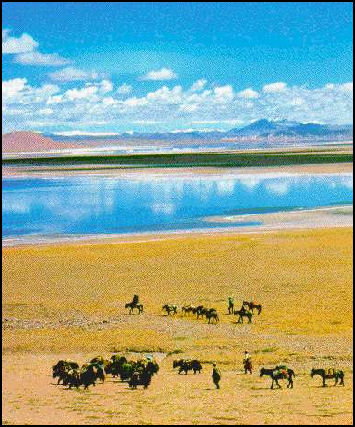
High altitude plainsAt higher altitudes, the body receives less oxygen with each breath as these is less oxygen and less pressure to push it into your body. Physical tasks become harder and parts of your body that need oxygen are deprived of it. Symptoms of altitude sickness include confusion, impaired judgment, headaches, nausea and poor balance.
At sea level there is adequate oxygen and high enough pressure to push the oxygen into the body. Breathing is easy; the blood carries oxygen at full capacity; the heart beat rate can range from 64 while resting to 170 while exercising. At 2,743 meters (9,000 feet) the level of oxygen is 75 percent what it is at sea level. Respiration speeds up and deepens and the body senses less oxygen in the blood; the brain swells slightly, producing headaches and nausea; the kidneys increase production of a hormone that triggers increased production of more red blood cells; and the heart beat rate ranges from 70 while resting to 155 while exercising.
The amount of oxygen available to the human body is determined by atmospheric pressure. At higher latitudes there is less pressure so less oxygen is available. The air is one third thinner at 4877 meters (16,000 feet) than at sea level and two thirds above 7620 meters (25,000 feet). Above 8,000 meters (26,247 feet) is regarded as the "death zone" by mountain climbers.
Acclimatization
Acclimatization is essential for outsiders. A person brought directly to the "death zone" from sea level would pass out within three minutes and die in 10 minutes from lack of oxygen. Fighter pilots, who reach altitude of 8000 meters without supplementary oxygen, fall into coma within 4-8 minutes. Climbers acclimatize by training at gradually higher elevations. Studies show that some people are born with an ability to adjust to high altitudes while others have genes that make them more likely to have breathing problems at high altitudes. Many people, even Sir Edmund Hillary, have found they have increasingly more difficulty adapting to high altitude as they age.
There is no need to hurry or exert your self while acclimatizing. You shouldn't climb higher than 300-500 meters (900-1500 feet) per day. Typically that is not so hard to do and you can easily go farther. But in the short term it could give you is headache and make you sleepless and possibly induce mountain illness in the morning. [Source: Tom Sjogren, mounteverest.net]
Many climbers get sick. The combination of the high latitude, poor food, bad water. stomach parasites and a new environment give people a Montezuma’s revenge-like nausea and diarrhea that is sometimes referred to in the Everest area as the Khumba Krud. It is not unusual for climbers to get dysentery. Not only are ailments dangerous in their own right they can also mean that climber are at less than their best and more likely to fall or have some other mishap.
Lack of Oxygen
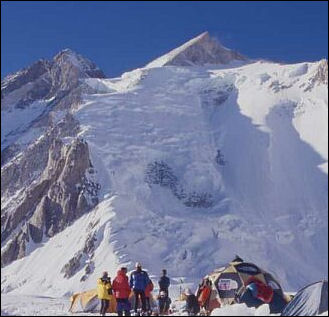
Gasherbrum I, HiddenPeak
Heavy breathing and dry air at high elevations causes the body to lose fluids at an alarming rate. Sometimes water content in the blood drops from a normal level of 50 percent to 15 percent and the number of red blood cells increases, causing the blood to circulate more slowly, increasing the risk of frostbite. Climbers carry stoves to melt snow, the only means of getting liquids. About ten pots of snow equals one pot of water.
The lack of oxygen prevents people from eating and sleeping and makes even simple chores like melting snow, putting on clothing, putting food into ones mouth exceedingly difficult. Each pace above 27,000 feet requires about half a minute. One step...six breaths...another step...six more deep breaths is how the climbers ascend during the final the assault of Everest.
The lack of oxygen in the brain can cause confusion, bad judgement and even self-mutilation. Climbers recall having imaginary conversations, distortions of time and space and hallucinations. Peter Habler, one of the first two men to reach the summit of Mt. Everest without oxygen, said, "In this lonely environment, which is so hostile to life, the imagination conjures up all manner of strange desires or horrifying apparitions.”
Strong climbers often have enormous lungs and the ability to function at high levels of aerobic activity for long periods of time. To compensate for the lack of oxygen climbers breathe 50 times a minute compared to 12 times at sea level. Most climbers breath oxygen from 13 pound oxygen canisters carried up to the camps by Sherpas to elevations as high as 27,000 feet. Four liters of oxygen is considered the best rate, but most climbers inhale two liters to make it last longer.
High Altitude Health Problems
At 18,000 feet (6,000 meters) there are no permanent settlements because no one can adjust to living at that elevation year round. The oxygen level is only 50 percent of what it is at sea level. The lungs expel so much carbon dioxide that the blood’s Ph balance is affected. Kidneys discharge more water to correct for the high levels of acidification in the blood, causing dehydration. The heart rate varies between 85 resting and 140 exercising.
The brain is sensitive to any kind of change, and high altitude conditions puts special stresses on it. The brain accounts for only 2 percent of the body’s weight but uses 15 percent of the body’s oxygen. Low amounts of oxygen can: 1) cause a dysfunction in the frontal lobe, resulting in impaired reasoning and memory; 2) produce plasma leakage from the corpus callosum, creating internal pressure; 3) create pressure on the cerebellum, resulting in staggering and loss of balance; and 4) put stress on the brain stem, resulting in coma and death, [Source: National Geographic, May 2003]
In A.D. 100 a Chinese official visiting the Tibetan plateau referred to the region as the "Headache Mountains." Tourists who visit the Tibetan plateau today often suffer from altitude-related ailments. Altitude sickness, frostbite and heart palpitations are very common in Tibet. Oxygen deprivation caused by thin air at high altitudes also causes brain function to decrease, the blood to thicken, the intestines to shut down, and the heart rate to become erratic.
Temporary blindness can occur when the brain’s visual cortex doesn’t get enough oxygen. It is also not unusual for blood vessels in the eyes to break. Such breakages aren’t painful but they can blur vision and take six months to heal. Climbers wear dark glasses in part because ultraviolet radiation, which increases at 4 percent per thousand meters, can also cause damage to the eyes.
Hypothermia and Frostbite
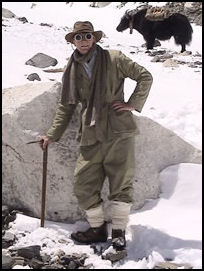
Everest climber Many mountaineers die of hypothermia — loss of body heat. In severe cases victims become so disoriented they take of their clothes and fight anyone who tries to help them. Climbers need to drink a lot. Even under normal conditions they exhale more than gallon of moisture a day.
According to mounteverest.net: “Hypothermia can kill in only 30 minutes. Cold temperature, but also strong wind causes the body to rapidly lose heat. You start to shiver in order to maintain body heat from the rapid muscular shaking. If your body temperature drops to 35 degrees C (95 degrees F) you'll get dizzy and disoriented. Then the shivering stops. The body now maintains temperature only around the important organs; heart, brain and lungs by shutting down blood circulation to the arms and legs. [Source: Tom Sjogren, mounteverest.net]
“At 30 degrees C (86 degrees F) your pulse is weak and slow. Your blood vessels widen. Now, you feel hot and want to remove your clothes, finally slipping into unconsciousness. At 24 degrees C (75 degrees F) your heartbeat stops. How fast you drop temperature will determine how rapidly you'll parish. 30 minutes is more than enough!
“Full blown Hypothermia will not be improved by additional clothing since clothing doesn't generate heat. In difficult climbing situations, you need to put hot water bottles in your armpits, to your crotch and/or stomach. As a last resort, strip and get into a sleeping bag — together with another undressed person, to warm up by the others body heat (yeah, yeah — keep your dirty imagination to yourself!).
“Otherwise — keep moving until at safety. In 1998, a climber died of Hypothermia on the North Side. All that was found left of him was his clothing neatly folded below the summit. This is quite typical of the condition. Confused, the brain tries to bring some order in the situation, thus folding the clothes.
“Prevent Hypothermia by adding on clothes as soon as you start feeling the slightest cold. Bring windproof clothing and lightweight downs in your backpack for the lower climbs, hot water bottles inside the down suit for the summit and don't pursue the climb if you start getting the symptoms of Hypothermia, unless you have no choice.
Frostbite is a condition in which the body parts freeze, turn black and die. It usually occurs on the extremities of the body first: the finger tips, toes and nose. Frostbitten body parts often have to be amputated to prevent gangrene from developing and spreading to the rest of the body, causing severe infection and quite possibly death.
Frostbite is particularly dangerous near summits of high mountains where winds can kick up to 90 mph and temperatures can drop many degrees below zero. Since the mid 1980s the development of efficient cold-resistance boots and Gortex gloves have greatly reduced the occurances of frostbite.
Altitude Sickness
Altitude Sickness may be a problem in high-elevation areas of the Himalayas, Tibet and high mountains of Central Asia. Acute Mountain Sickness (AMS, altitude sickness) causes fluid to form in the brain and lungs and kills by causing the brain to swell and hemorrhage inside the skull. Many people die of it every year, and there is no rhyme or reason to who it strikes (sometimes fat smokers are unaffected while athletes get sick).
Describing altitude sickness, one mountain climber told the Washington Post, “You feel terrible, your head is pounding, your body failing, you can’t think, you can’t move. I was fit, but I couldn’t lift my head on my shoulders.”
The effects of the low oxygen on body tissues are noticeable above 3,500 meters (11,480 feet) and marked above 5,000 meters (16,400 feet). Symptoms include headaches, nausea, vomiting, lightheadedness, lassitude, breathlessness, anorexia, fatigue, insomnia, swelling of hands, feet, or face, and decreased urine output.
People with severe AMS have difficulty breathing with minimal activity, feel extremely tired, and have a dry cough. When the disease becomes more advanced the victims have bubbly breathing, cough up fluid or blood, feel confused and become bluish in color.
Above 12,000 feet a swelling of the brain called HACE (high altitude cerebral edema) may occur. The first symptom of this disease is a severe headache, hallucinations, stumbling walk, drowsiness and faulty judgement (which can make self-diagnosis difficult). Brain damage and death can occur quickly. As is true with AMS, the best treatment for a cerebral edema is to descend quickly.
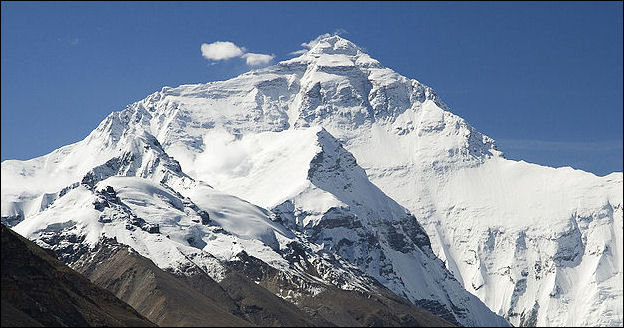
Everest, Tibetan side
Altitude Sickness Prevention and Treatment
AMS generally affects people who ascend too quickly at elevations above 8000 feet. Those who fly from sea level to a higher elevation should be especially careful. The general rule of thumb is to "climb high and sleep low" and ascend no more than 1000 to 1,500 feet a day and take every third day off. If you ascend more than that rest a day or two. Even if you are super fit that is no guarantee you won't have problems.
The only cure for AMS is to descend to a lower elevation. If you experience any of the aforementioned AMS symptoms, descend immediately, the more you don't want to the more imperative it is that reach you lower elevations, even if it is rainy night.
To prevent altitude sickness eat and drink a lot. Diamox tablets are often prescribed as a preventative measure. They generally only treat the symptoms of mild AMS put do nothing to prevent the condition. Many local people chew on raw garlic.
Edemas
Edemas, the accumulation of excess fluid in the body, are big dangers, especially when they occur in the brain (cerebral edemas) and the lungs (pulmonary edemas). A physician who has reached the summit of Mt. Everest four times told National Geographic, “I can honestly say I’ve never gone to Everest without seeing someone suffer from cerebral edema.”
A cerebral edama occurs when plasma leaks through the capillary walls, increasing pressure in the skull. Why the brain capillaries leak is still somewhat of mystery (possible reasons include new capillary growth in low-oxygen conditions, separation of junction between cells, inflamation of the vessels). The amount and kind of damage causes often depends on how much and where leakage occurs.
A pulmonary edema occurs when blood vessels are squeezed inside the lungs. The constrictions and high pressure cause the fragile lung capillaries to leak fluids which inhibits the ability of the lungs to collect oxygen and this causes the victim to drown in his own secretions.
In the past it was thought that edemas were caused by swollen cells rather than leakage and by inflammation or heart failure not constriction. Studies shows the body produces nitric oxide, a chemical that dilates the blood, to reduce constricting of the blood vessels. Some studies suggest hat people who do not produce adequate amounts of nitric oxide are more susceptible to pulmonary edemas.
Types of Mountain Sickness and What to Do About Them
Normal acclimatization: Symptoms: 1) Some headache), 2) irregular breathing at night, 3) rapid breathing at day, 4) increased urine output. What to do: take aspirin to relieved the headache [Source: Tom Sjogren, mounteverest.net]
Moderate mountain sickness: Symptoms: 1) Some sleeplessness, 2) decreased urine output, 3) persistent headache not relieved by aspirin. What to do: Stay at your current altitude for some time (1-2 days) until you feel well. Don't climb higher!
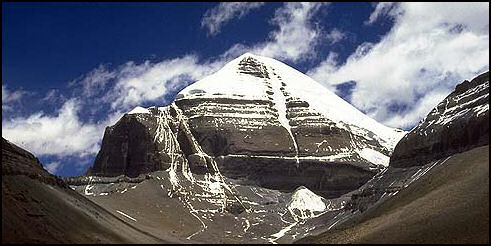
Mt. Kailas
Acute mountain sickness (AMS): Symptoms: 1) Dizziness, 2) vomiting, 3) losing your balance, 4) persistent coughing, 5) sleepiness. What to do: Go down at least 500 meters (1500 feet) immediately. Consult a doctor (on the walkie-talkie) and take emergency medicine.
High Altitude Cerebral Edema (HACE) and Pulmonary (HAPE) Edema are very serious. Both HACE and HAPE occur after when someone pushes on despite AMS. They are the typically result of too much, too fast and a general negligence to the body's subtle or in the end, not so subtle warnings.
Cerebral edema: Symptoms: 1) failure of motor function, 2) vomiting, 3) hallucinations, 4) extreme sleepiness and 5) ataxia (can't walk heel to toe). Try to walk a straight line or point your nose if you suspect it. What to Do: Oxygen, Gamow bag-treatment, Diamox and Decadron are helpful, but the most important is rapid descent.
Pulmonary edema: Symptoms: 1) blue lips, 2) very heavy breathing, 3) gurgling sound when breathing. What to Do: Oxygen, Gamow bag-treatment, Diamox and Decadron are helpful, but the most important is rapid descent.
According to mounteverest.net: Never cook inside a sealed tent. The gas withdraws the oxygen from the air and this can cause HACE/HAPE conditions in your sleep. Sometimes we have to push the limits. Storms and other acute situations might force us into circumstances that we don't like. That's one thing. But to come up with AMS due to impatience and ignorance is sad. It could cost you your life. HAPE and HACE kill fast.
Being Safe at High-Altitudes
The main pieces of advise for staying healthy in high altitudes are: 1) don’t ascend too fast (500 meter a day is the standard recommendation); 2) get plenty of rest; and 3) Drink lots of water. The last advise can not be emphasized enough. A whole slew of high-altitude health problems like headache, edema, frostbite, confusion and such are often related to dehydration then lack of oxygen.
According to mounteverest.net: Respect the weather. Bad weather can turn an easy, sunny climb into a horrible, fatal inferno. The change is often fast and unforgiving. Suddenly, you are blind, the wind freeze the blood in your veins, you can't think and you can't find your way anywhere! Instantly, you feel a deadly fear whilst your mind keeps falling into a helpless dizziness. You cant feel your fingers, you can't feel your toes — there is ice on the white, dying tissue of your face and the roaring wind drowns your fellow climbers' desperate yells for each other. It's too late for everything. On prolonged climbs, bad weather might strike unexpectedly, contrary to forecasts of fine conditions. The mountain creates its own weather, impossible to predict well by todays models and especially without a weather station on the summit.
Know yourself. A lot of strange feelings, reactions and symptoms occur at altitude. For instance; going high causes your brain to lack oxygen. A brain short on oxygen reacts by depression. In the old ages, when people slept in four-poster beds hung with thick velvety curtains, people lacked oxygen at night. Thats why this time in history is called the "nightmare-age". It's the same phenomena. The brain reacts on oxygen depravation by nightmares at night and bad moods during the day. Going down instead floods your brain with oz and you will get euphoric. This instead can cause psychosis. In dangerous situations, we all react differently. Some freeze, some panic, some are rational. How will you react? The knowledge of different situations at altitude — and your own reactions to them — is important for your self-confidence and essential for survival.That's why experience with altitude is so important prior to an Everest climb.
Don't forget to donate left over pills to local clinics. That always short on medical aids.
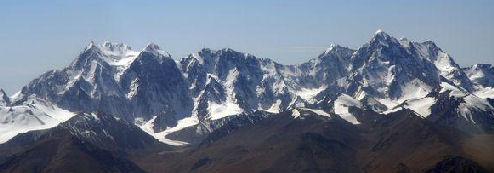
Make Sure to Drink Lots of Water
Drinking lot of water is critical to staying healthy and alert in high-altitude, low-oxygen conditions. According to mounteverest.net: The lack of oxygen at altitude cause your body to need more red oxygen carrying blood cells. Each new blood cell will pick up oxygen from the air and hurry it to your tissues. Your spine will therefore soon start to produce this new blood. The drawback is that the new blood cells will make your blood very thick. You will see it clearly if cutting your finger — the blood is dark and syrupy. [Source: Tom Sjogren, mounteverest.net]
Thick blood means slow circulation and the blood unable to reach your finer blood veins — the capillaries. The oxygen transportation will be slow and inefficient with that. When your tissues don't get warm blood to heat them — they will start to freeze. You suffer frostnip. The cells in your body begin to collect fluid. Your lung fills up and you drown in your own body fluid (HAPE). The brain swells up (HACE). The body will collect water from everywhere it can — your intestines for instance. As your bowels don't get enough water to make the waste soft you can't get rid of it (it is small and hard as a rabbits and really painful). Water ends up everywhere in your body, except were it should be ' in the blood. Your muscle cells don't get oz and you climb slowly and heavily.All these altitude symptoms happen because the fluid balance in your body is messed up.
There is a very simple way to keep the blood nice and thick with the precious oxygen-providing red blood cells intact, and still happily free flowing to all the tiniest corners of your system: WATER! You need around 4-5 liters of water at altitude to feel great. Simple as that. Drink. Drink, Drink! The best way to check that you are well hydrated is to check your urine. You need to drink until it's almost white.
It's not of much use pumping your blood full with oz when climbing on oxygen support, if it still can't get anywhere due to slow circulation. A well-hydrated climber with NO oxygen support can actually perform BETTER than a dehydrated climber ON oxygen. Obviously, being well hydrated and on oxygen, will be your best bet. We rid us of headaches, hemorrhoids, edema, fatigue — everything, just by drinking! Try to drink 1-2 liters, 1-2 hours before the climb and you will feel a dramatic difference in your climbing performance.
Image Sources: Wikimedia Commons, Purdue University except Everest by Luca Galuzzi
Text Sources: New York Times, Washington Post, Los Angeles Times, Times of London, National Geographic, The New Yorker, Time, Newsweek, Reuters, AP, Lonely Planet Guides, Compton’s Encyclopedia and various books and other publications.
Last updated September 2022
